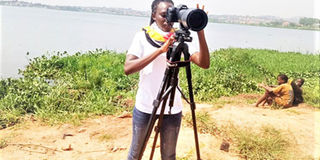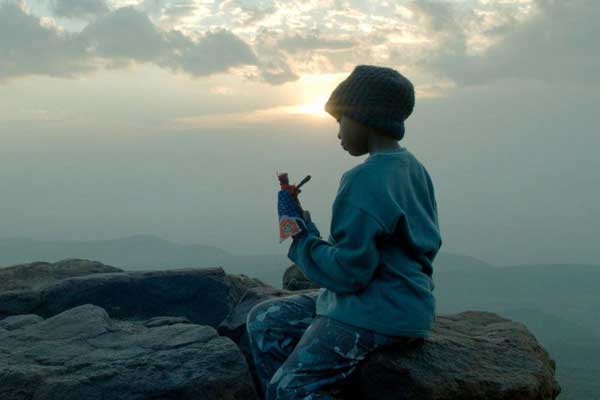Birding: The fastest growing recreational and lucrative activity

Mercy Amucu wants to become a professional bird guide PHOTO/COURTESY
What you need to know:
Attributes such as colour and shape of bill, shape of legs, number of wing bars, tail colour and the existence of stripes and the overall size are some of the details that must to be documented during birdwatching. Patience too is a virtue of a good birdie.
Mercy Amucu Kabirye, a zoologist, has loved birds since childhood. They intrigue her with their colours, sounds and way of life. Three years ago, Amucu decided to make birdwatching a lifestyle. She is currently a trainee with Bird Uganda Safaris, a tours and travel company that gives birding treats in Africa.
She is developing her birdwatching skill set, especially on weekends. She switches from life as a water engineering student at the Lugogo Vocational Training Institute into birdwatching. “We watch in groups but sometimes, I do it alone,” she says.
The swampy areas of Luzira, a Kampala suburb, Lutembe bay, Ziwa Rhino Sanctuary, Botanical Gardens in Entebbe, Mabamba Wetlands which are located on the northern shore of Lake Victoria, 12km west of Entebbe and Mabira Forest Reserve are all good bird watching destinations within a short radius from the city centre.
It gets more interesting upcountry in places such as Lake Mburo National Game Park where Amucu’s first birdwatching training with Bird Uganda Safaris began. “There is a lot about birds that you can spend hours watching,” she says.
It takes some notes and patience for one to mature into a birdwatcher. Experts say birdwatching is more than just roaming around with a pair of binoculars. It is about testing one’s ability to spot a bird or locate it with the help of its sound.
“The first thing you are taught is how to see a bird. Without training, one can go birdwatching and end up seeing nothing yet there are birds all around. It is because they do not know how to locate them,” explains Amucu.
For one to locate birds, other skills are required; the need to identify details about a particular bird. Attributes such as colour and shape of bill, colour and shape of legs, number of wing bars, tail colour and the existence of stripes, shape and the overall size are some of the details that have to be documented. Patience too is a virtue of a good birdie. Sometimes, one has to wait for long hours in order to see birds or specific bird species.
Amucu says for every bird watching adventure, the goal is to see new species. “My best experience is seeing new birds. But this does not happen all the time,” she explains.
Three years into her training, she says she keeps acquiring more knowledge each day. The experienced birders she meets in the field play a big role in growing her passion for birdwatching.
Best birding experience
She wants to graduate into a professional bird guide with familiarity with species in the region. In her three years of birdwatching, Amucu points out the lilac-breasted roller as the bird she enjoys watching the most. “It is a beautifully coloured African bird known for its acrobatic aerial displays during the breeding season. The males and females are inseparable in looks. I love it because of the blend of colours it has,” she says.
A chat with the Uganda Bird Guides Association member, Davis Rukundo, reveals more about the activity. Rukundo is also a freelance tour guide whose passion for nature is unrivalled. “I was part of the group of five children that started the young birders association back in the day. Two of us are still on course while the others have moved on,” he says.

Hornibills have long and down-curved bills and are brightly coloured birds. They are common in Murchison Falls National Park. PHOTO/NET
Rukundo says their parents loved nature and passed it on to them. Like any birder, it is Rukundo’s love for nature that turned him into a birder early on in his life. He wakes up every day to learn the behavioural patterns of birds. “I love discovering and studying the details of birds. And while many people visit tourist attractions to see the big wild animals, many tend to underlook birds because they are small,” says Rukondo who is in his second term as the guides’ body leader.
Rukundo says birding is the easiest activity to adapt to. “All you need are your eyes, there are no key necessary skills or tools but one’s passion and drive. Anybody can do it,” he says. The fact that birds are all over the place makes it even easier, in villages, in urban centres and people’s compounds.
Numbers of birders on the rise
The number of birders in recent times excites Rukundo although he believes the activity can be explored more. “We have more birders than ever before. Back then, we would organise birding activities and few would show up. Today, many people are beginning to pick interest in the activity,” says Rukundo.
He wants to get birders at a young age like he was with his other four childhood friends. He believes encouraging parents to come along with their children on nature trips is one way of achieving that. The birdwatching fraternity has come a long way from the days when they were misunderstood.
Rukundo credits the progress to Herbert Byaruhanga, whom he refers to as the ‘godfather’ of birdwatching in Uganda. “Back in the day, locals had no idea what birdwatching was and had issues with birders. There were times when the police arrested birders after mistaking binoculars for spying equipment,” he recollects.
Key names in birding
Byaruhanga is also the first chairperson of the body that was birth in 1998, and remains one of the oldest indigenous guides.
Rukundo has birwatched for more than a decade and seen all manner of birds, by the time you are trusted with a second term for the top seat of the bird guides’ club, the CV is one of steel.
He has seen many birds and landed on a number favourites, making it hard for him to single out which species stand out for him. After a long silence he gives in “the Abyssinian ground thrush.” It was a bird he had heard of but never seen. It is a large brown-beacked, orange-breasted thrush with bold white wing bars.
It has an orange crown, a plain face, and a complete white eye-ring. It is usually shy and rarely seen as it is restricted to areas of Bwindi. It rarely makes sounds but its singing comes off as a chatty and cheerful series of whistles and chuckles.
“We were told it was nesting and looked for it for two hours until we found it. We tracked it to its nest and studied it with our clients,” he says. Rukundo is fascinated by how it stands out under the dark Bwindi Impenetrable Forest. As he completes his second term, whoever comes after him has a major target of growing the tourism product at different levels, starting with children.
Birdwatching has grown into a lucrative activity. It is one of the fastest rising outdoor recreation activities in the country. According to the Uganda Tourism Centre, the country is blessed with a sum of 1,061 bird species, making it one of the highest populations in the world.
It also constitutes half of Africa’s bird species and 11 percent of the world. With water bodies, there is availability of countless bird watching spots all over the country.
Birding spots
Uganda’s bird species come in different shapes, sizes and colours. They all offer birders something to look out for. These include the shoebill stork, African green broadbill, black bee-eater, brown chested pullover, brown-chested lapwing, green-breasted Pitta, Jahan’s Francolin, Jameson’s Antpecker, Karamoja Apalis, purcell’s illadopsis, Puvel’s Illadopsis, Nahans francolin, Red fronted anti pecker and the Rwenzori turaco.
Other species that can be spotted during bird watching safaris include the African Harrier hawk, Cinnamon-chested bee-eater, crowned hornbill, Giant kingfisher, Goliath Heron, Green pigeon, Martial Eagle, Mountain greenbul, the Secretary Bird, Shelley’s crimsonwing, Short-tailed warbler, The African Darter, The grey crested crane, Western green tinkerbird and Yellow-billed stork, among others.
Top birding spots in Uganda
Uganda has about 34 important bird areas (IBA). An Important Bird and Biodiversity Area is an area identified using an internationally agreed set of criteria as being globally important for the conservation of bird populations. IBA was developed and sites are identified by BirdLife International.
There are more than 13,000 IBAs in the world, meant for birdwatching and birding tours. However, new bird spots continue to be discovered in the country.
Some of the most visited birdwatching spots in Uganda include Bwindi Impenetrable National Park which is Africa’s number one birding spot according to the African Bird Club, the Mabamba Bay Wetland that is known for the Shoebill.
Others are Entebbe Peninsula, Lutembe Bay wetland, Kibale Forest National Park,Rwenzori Mountains National Park, Kidepo Valley National Park, Lake Mburo National Park, Queen Elizabeth National Park, Semuliki National Park, Budongo Forest, The Royal Mile trail and Busingiro and Murchison Falls National Park.
Growth
Birdwatching has grown into a lucrative activity. It is one of the fastest rising outdoor recreation activities in the country. According to the Uganda Tourism Centre, the country is blessed with a sum of 1,061 bird species, making it one of the highest populations in the world. It also constitutes half of Africa’s bird species and 11 percent of the world. With water bodies, there is availability of countless bird watching spots all over the country. Uganda has about 34 important bird areas (IBA). An Important Bird and Biodiversity Area is an area identified using an internationally agreed set of criteria as being globally important for the conservation of bird populations. IBA was developed and sites are identified by BirdLife International.




